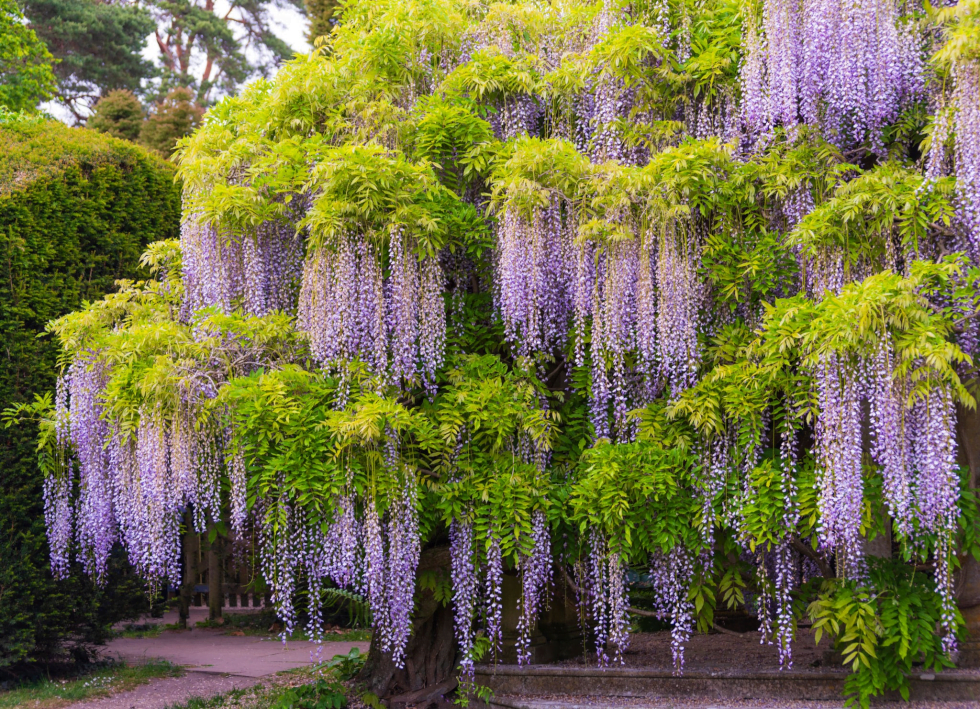Caring for Wisteria
Caring for wisteria in January/February, when it is dormant and leafless, is crucial to ensure its health and vigor when it bursts into cascades of fragrant blooms during spring and summer. Here are some essential tasks for tending to your wisteria during this winter month:
Pruning
- Trim away any dead, damaged, or diseased branches. This helps maintain the overall health of the plant.
- Cut back shoots you pruned in the summer to two or three buds to tidy it up before the growing season which also prevents blooms being hidden by leaves.
- Prune long, unruly shoots to control the shape and size of the wisteria. This is especially important for encouraging the development of flowering spurs.
Winter Tidying
- Remove any debris or fallen leaves around the base of the plant to reduce the risk of pests and diseases.
Inspect for Pests and Diseases
- Check for signs of pests or diseases, such as scale insects or fungal issues. If identified, take appropriate measures to address them promptly.
Soil Moisture Check
- Ensure that the soil around the wisteria is not waterlogged. While the plant is dormant, it’s essential to maintain well-draining conditions to prevent root rot.
Feeding
- Apply a balanced fertilizer around the base of the wisteria. This provides essential nutrients that support healthy growth and flowering.
Securing Structures
- Check any supporting structures, such as trellises or wires, and ensure they are secure. The weight of the wisteria during the growing season can be substantial, so proper support is crucial.
Remember, wisteria is a vigorous plant that benefits from regular attention and care. By addressing these tasks in January, you set the stage for a beautifully blooming wisteria when spring arrives.
If you are thinking about planting wisteria, The Nursery stocks several varieties but some consideration is required to ensure the plant thrives in the local climate and soil conditions. We strongly advise you seek guidance from our staff to assist in selecting the best variety for your circumstances and planting advice. Here are some general guidelines for planting wisteria:
Choose the Right Variety:
- There are several varieties of wisteria, but two common types are Wisteria sinensis (Chinese wisteria) and Wisteria floribunda (Japanese wisteria). Make sure to choose a variety that is suitable for the your environment.
Select a Suitable Location:
- Sunlight: Wisteria prefers full sun, so choose a location that receives at least 6 hours of direct sunlight each day.
- Soil: Wisteria can tolerate a range of soil types, but it does best in fertile, well-drained soil.
Planting Time:
- Plant wisteria during late autumn or early spring when the plant is dormant.
How we can help
- FREE face-to-face advice at The Nursery. Our staff are trained to provide quality advice.
- Wisteria plants of great quality are in stock
- Pruning – we sell a range of quality secateurs and loppers.
- Tidying – we stock a variety of rakes and tools to keep your garden tidy.
- Pest & Disease – advice available plus a great range of fungicides and pesticides.
- Feeding – a wide variety of fertilizers, composts and plant feed is available at The Nursery.
- Structure – Trellis and wire is available to assist training your wisteria.
- Pots – thinking of pot-grown wisteria? – we have a massive range of pots & containers to suit all your needs.
Matt
The Nursery Garden Centre near Trowbridge is owned and operated by Matthew Webb, a professional horticulturist . Matthew built it from scratch and loves his job, his staff and his customers. Plants are his passion and he adores growing, nurturing and knowing as much as possible about them and then passing on his expert knowledge to staff and customers.




